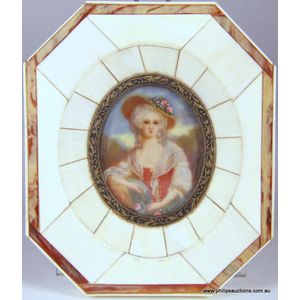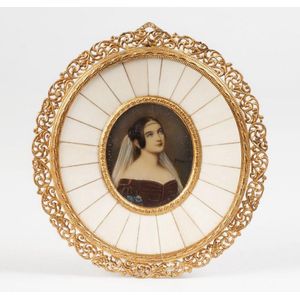Miniature Women: Watercolor and Ivory Portraits
You must be a subscriber, and be logged in to view price and dealer details.
Subscribe Now to view actual auction price for this item
When you subscribe, you have the option of setting the currency in which to display prices to $Au, $US, $NZ or Stg.
- Ivory - Ivory is a hard white material that comes from the tusks of elephants, mammoth, walrus and boar, or from the teeth of hippopotamus and whales. The ivory from the African elephant is the most prized source of ivory. Although the mammoth is extinct, tusks are still being unearthed in Russia and offered for sale.
Ivory has been used since the earliest times as a material for sculpture of small items, both in Europe and the east, principally China and Japan.
In Asia ivory has been carved for netsuke, seals, okimono, card cases, fan supports, animals and other figures and even as carved tusks.
In the last 200 years in Europe ivory has been used to carve figures, for elaborate tankards, snuff boxes, cane handles, embroidery and sewing accessories, in jewellery and as inlay on furniture. Its more practical uses include being used for billiard balls, buttons, and a veneers on the top of piano keys.
The use and trade of elephant ivory have become controversial because they have contributed to Due to the decline in elephant populations because of the trade in ivory, the Asian elephant was placed on Appendix One of the Convention on International Trade in Endangered Species (CITES), in 1975, and in January 1990, the African elephant was similarly listed. Under Appendix One, international trade in Asian or African elephant ivory between member countries is forbidden. Unlike trade in elephant tusks, trade in mammoth tusks is legal.
Since the invention of plastics, there have been many attempts to create an artificial ivory
This item has been included into following indexes:
-
miniatures
- 20th century 99
- portrait and other 1,173
Visually similar items

A German miniature painting in an ivory frame, the oval image of a late 18th century style woman with a floral hat and a laced bodice recessed in an ivory panelled octagonal frame with an agate coloured border. Height 10 cm. Width 8.5 cm

Fine antique French oval gilt surround mirror, approx 142 cm high, 103 cm wide

A Tower clock, Fritz Ziegeler, Melbourne, 41 cm high, 53 cm wide, 48 cm deep (movement). Other Notes: Johann Frederick Wilhelm Ziegeler was born in Hanover, Germany in 1855. He completed an apprenticeship in scientific instrument trade and subsequently spe

A Victorian giltwood and gesso overmantle mirror, the oval mirror surmounted by ribbon, flowers and birds. Height 215 cm. Width 170 cm
